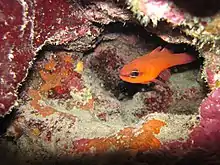Kurtiformes
The Kurtiformes /ˈkɜːrtɪfɔːrmiːz/ consist of two extant families of ray-finned fish, the Indo-Pacific Kurtidae (consisting solely of the two species of nursery fish) and the much more diverse and widespread Apogonidae (the cardinalfishes). The order is part of the Percomorpha clade and is regarded by many authorities as a sister taxon to the Gobiiformes.
| Kurtiformes | |
|---|---|
_(6918416854).jpg.webp) | |
| Kurtus indicus | |
 | |
| Apogon imberbis | |
| Scientific classification | |
| Kingdom: | Animalia |
| Phylum: | Chordata |
| Class: | Actinopterygii |
| Clade: | Percomorpha |
| Order: | Kurtiformes D.S. Jordan, 1923[1] |
Relationshiops and defining characteristics
A close relationship between the Kurtidae and Apogonidae was postulated based on the similarity of constituent parts of their dorsal gill arches and that in both groups the eggs have filaments on the micropyle, which enable the eggs to form a mass. This mass is brooded in the mouth in the Apogonidae and borne on the supraoccipital hook of at least one of the two nursury fishes in the Kurtidae. They also have horizontal and vertical rows of sensory papillae on their heads and bodies, which are often arranged in a pattern resembling a grid (similar patterns of sensory papillae can be observed in some species in the Gobiiformes). The two families comprising the Kurtiformes are recovered as sister groups in some molecular phylogenies, but others instead recover them as successive sisters to the Gobiiformes.[2]
Families
Two extant families are classified under the order Kurtiformes:[3]
- Kurtidae (Bleeker, 1859) - nurseryfish
- Apogonidae Günther, 1859 - cardinalfish
References
- "Kurtiformes". Paleobiology Database. Retrieved 17 September 2018.
- J. S. Nelson; T. C. Grande; M. V. H. Wilson (2016). Fishes of the World (5th ed.). Wiley. p. 752. ISBN 978-1-118-34233-6.
- "Kurtiformes {order} - Chordata; Actinopterygii". BOLD Systems. Retrieved 17 September 2018.